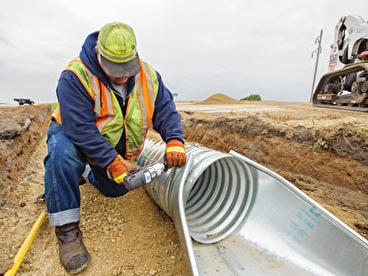Thorough Underbrush Clearing for Land Management
Thorough Underbrush Clearing for Land Management
Blog Article
Culvert Installation Made Easy: Step-by-Step Guide for Success
Installing culverts may seem like an uncomplicated job, but making sure an effective result calls for careful planning and execution. From choosing the proper culvert size to integrating appropriate drain actions, each step in the setup procedure plays an important function in the performance and longevity of the culvert system. By following a methodical method and taking notice of key information, the setup can proceed efficiently, reducing possible problems down the line. Remain tuned to uncover the crucial steps and considerations that can make culvert installment a seamless and effective venture.
Choosing the Right Culvert Size
Picking the proper culvert dimension is important for ensuring effective water flow and structural honesty in culvert installation jobs - Pad Construction. The dimension of the culvert directly impacts the circulation capacity of water with the framework. A culvert that is too little can bring about flooding and overflow, while one that is also big might result in decreased water speed, possibly causing debris buildup and obstructions
To establish the right culvert size, variables such as the watershed location, optimal flow rates, and hydraulic effectiveness demand to be meticulously taken into consideration. Computations based upon these criteria aid in selecting a size that can adequately take care of the anticipated water volume while lessening the threat of clogs and architectural failure.
It is important to seek advice from design standards and criteria to make sure that the chosen culvert size meets the project requirements and local policies (Pad Construction). By picking the appropriate culvert dimension, task supervisors can enhance water circulation, stop potential concerns, and boost the total effectiveness and longevity of the culvert installment
Preparing the Installation Site
Efficient culvert installation demands thorough prep work of the installment site to guarantee optimal structural assistance and capability. Before commencing the installation procedure, it is critical to remove the site of any particles, plant life, or blockages that might impede the culvert's positioning. Making sure a level foundation is essential for the correct positioning and stability of the culvert. This might include grading the site to create a smooth, also surface that can properly sustain the weight of the culvert and any kind of anticipated lots. Furthermore, proper compaction of the dirt underneath the culvert is essential to stop settling or moving over time.
In addition, it is important to consider aspects such as dirt structure, groundwater degrees, and environmental impacts when preparing the setup site. Carrying out a detailed website evaluation can assist determine any type of possible go to my blog obstacles or threats that may influence the culvert's efficiency. By taking the time to prepare the installation site correctly, you can help assure an effective culvert installment that fulfills architectural needs and makes certain lasting performance.
Positioning the Culvert Appropriately

The grade at which the culvert is placed is important for keeping a correct incline for water flow. In addition, the culvert should be oriented correctly to guarantee that the inlet and outlet are in the appropriate places. Pad Construction.
Backfilling and Compacting the Dirt
Correct backfilling and compaction of the soil around the culvert is necessary to make certain security and protect against possible concerns in the future. Once the culvert is correctly placed, the next websites crucial step find out here is to backfill the location around it with suitable product. The backfill material ought to be without rocks, particles, and organic issue to stay clear of damage to the culvert. It is advised to utilize granular product such as sand or gravel for backfilling, as it supplies excellent drainage and compaction buildings.
After putting the backfill material, it is essential to portable it in layers of uniform density. Utilizing a compactor or a mechanical meddle, portable the soil gently to stay clear of damaging the culvert. Compaction aids in minimizing the possibilities of settlement and makes certain uniform support around the culvert. It is crucial to compact the dirt uniformly on all sides of the culvert to keep its structural integrity.
Proper backfilling and compaction not just give security to the culvert but additionally help in protecting against soil disintegration and maintaining the longevity of the culvert system.
Guaranteeing Appropriate Drainage Combination
Incorporating effective drain remedies plays an essential role in the general capability and longevity of culvert setups. Correct drainage combination is vital for managing water flow, protecting against erosion, and guaranteeing the architectural honesty of the culvert system. To achieve this, it is essential to create a thorough drainage plan that thinks about aspects such as the quantity of water anticipated, the topography of the location, and the type of soil present.

In addition, integrating features like disintegration control procedures, such as riprap or vegetation, can even more enhance the performance of the drain system. By thoroughly planning and applying these drain solutions, culvert installations can work efficiently and hold up against the test of time.
Verdict
In verdict, proper culvert installment is important for preserving reliable drainage systems. By picking the best culvert dimension, preparing the setup website, putting the culvert appropriately, backfilling and compacting the soil, and ensuring correct drainage assimilation, success can be achieved. Complying with these steps will aid ensure the longevity and efficiency of the culvert, ultimately adding to the total success of the drainage system.
Report this page